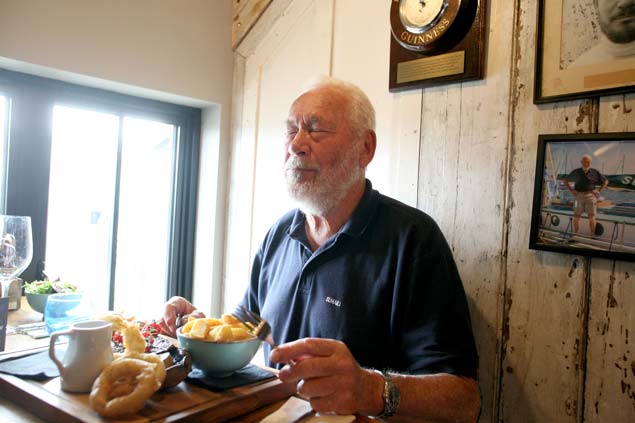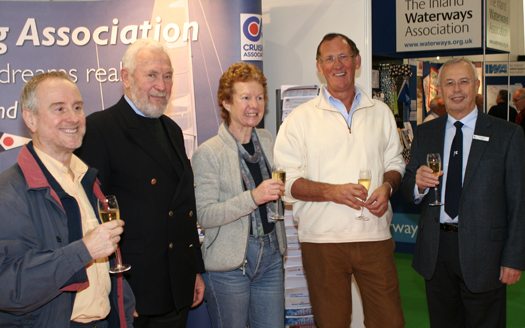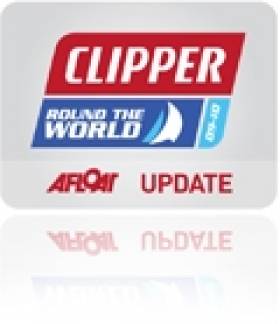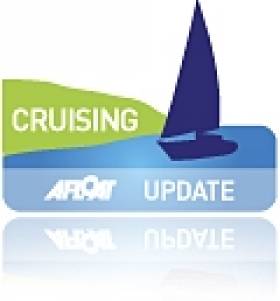Displaying items by tag: Robin KnoxJohnston
Falmouth Celebrates 50th anniversary of Sir Robin Knox-Johnston’s Departure in 1968 Golden Globe Race
Fifty years to the day after Sir Robin Knox-Johnston set out from Falmouth UK in his rugged 32ft yacht Suhaili to become the first man to sail solo non-stop around the Globe, the British master mariner returned yesterday to lead a celebratory parade of sail around the harbour. Watched by visitors on every headland, the 200-strong armada of sail crisscrossed between Falmouth and St Mawes before Sir Robin set up a start line between Suhaili and Sir Francis Chichester’s equally famous yacht Gipsy Moth IV and fired the canon to set the 17-strong fleet of 2018 Golden Globe Race yachts (including Ireland’s Gregor McGuckin in his Biscay 36 Hanley Energy Endurance) on their way to Les Sables d’Olonne for the start of this 50th anniversary solo circumnavigation on Sunday July 1st.
The Suhaili Parade of Sail was the culmination of a 3-day festival involving Suhaili, Gipsy Moth IV, the replica fleet of Golden Globe Race yachts and vessels from around the UK and Europe which had gathered in Falmouth to honour Sir Robin Knox-Johnston’s achievement in the original Sunday Times Golden Globe Race back in 1968/69.
 Start of Falmouth to Les Sables-d’Olonne race – Gregor McGuckin’s Biscay 36 Hanley Energy Endurance on the right
Start of Falmouth to Les Sables-d’Olonne race – Gregor McGuckin’s Biscay 36 Hanley Energy Endurance on the right
The Mayor of Falmouth, Cllr Grenville Chappell said: “It’s amazing to think it was 50 years ago - it seems only yesterday - that Falmouth welcomed Sir Robin Knox-Johnston back into port after his incredible and historic sailing achievement, one that captured the hearts and minds of millions of people around the world. His exploits then and subsequent, have inspired many across the UK and beyond to get out on the water, take up sailing or indeed undertake their own adventures. It certainly made an indelible mark on Falmouth’s community and we are thrilled to see Sir Robin and his legendary yacht Suhaili back in town. We’re delighted to be the host port for the Suhaili 50 Falmouth Parade of Sail jamboree. Our community has come together so well to assist, so a particular thank you to Falmouth Town Council, Falmouth BID, Falmouth Harbour Commissioners, Royal Cornwall Yacht Club, St Mawes Sailing Club and St Austell Brewery for their support.”
"The Suhaili Parade of Sail was the culmination of a 3-day festival involving Suhaili, Gipsy Moth IV & the replica fleet of Golden Globe Race yachts"
Sir Robin Knox-Johnston said: “It is wonderful to be back in Falmouth and to receive such a warm welcome. Everyone has been very kind. This week’s celebrations have brought back so many memories.”
One of those memories is of a barometer, ‘borrowed’ off a pub wall before Sir Robin set out on his solo first which he used to monitor the changing weather conditions during his 312 day voyage. The original was later stolen from his yacht but Sir Robin returned with a replica of that faithful 'A Lovely day for a Guinness' branded barometer to present to the Chain Locker Pub where he stayed 50 years ago before his departure and on his return.
And to mark his return to this famous harbour-side hostelry, staff served Sir Robin with the same meal of steak and chips followed by lemon meringue pie he had ordered when he first returned to Falmouth on 22nd April 1969.
 Robin Knox-Johnston savours the moment with a re-creation of the meal he had in The Chain Locker pub on Falmouth town waterfront when he returned from his great voyage 50 years ago.
Robin Knox-Johnston savours the moment with a re-creation of the meal he had in The Chain Locker pub on Falmouth town waterfront when he returned from his great voyage 50 years ago.
First of the 2018 Golden Globe Race yachts to cross the line at the start of the SITRaN Challenge race to Les Sables d’Olonne was Tapio Lehtinen’s Finnish yacht Asterisk closely followed by 72-year old Jean-Luc Van Den Heede’s French entry Matmut and the two bright orange painted entrants Mark Sinclair’s Australian yacht Coconut and Istvan Koper’s USA/Hungarian entry Puffin, with Gregor McGuckin’s Hanley Energy Endurance settling into fifth place as the fleet reached open water.
Palestinian skipper Nabil Amra, who has still to complete his 1,000 mile solo proving trial, set out later in the day and must sail a further 300 solo distance once he arrives at the French port in order to qualify for the Race.
#clipperskipper – There will be no Irish skipper in the next Clipper Round the World Yacht Race but the world's longest global race has revealed its most diverse ever line-up of professional skippers who will lead their amateur crews in the tenth edition of the world famous challenge, setting sail on August 30, 2015.
For the first time in the Clipper Race's nineteen year history, the group of twelve professionals includes two women skippers, from Canada and Australia, and the first ever skippers to represent France and Ukraine/Germany. The UK is also strongly represented with skippers from Scotland, Somerset, Cornwall and Hampshire.
Sir Robin Knox-Johnston, Clipper Race founder and Chairman, said: "In preparation for our tenth edition Clipper Race, I feel very proud to welcome our most diverse and international group of race skippers yet.
"This is the first time we've had two women skippers in one race and I very much hope they will inspire future female participation. I'm also delighted to see the Clipper Race broadening its professional appeal as we welcome our first French and first Ukrainian/German skippers."
Adding, he said: "Clipper Race crew come from all over the world so I'm pleased to reflect this in our leadership. I look forward to working with all our skippers over the coming months as they prepare for another thrilling race."
The Clipper Race is one of the world's toughest challenges. 40,000 nautical miles long, taking almost a year to complete, this is the only event of its kind which gives amateur sailors the chance to sail round the world, taking on Mother Nature's most remote conditions. Fewer people have completed the Clipper Race than have climbed Mount Everest.
Hoping to follow the success of compatriot Eric Holden, Clipper 2013-14 Race winner, Canadian skipper Diane Reid, 42, from Toronto said: "The Clipper Race combines all my passions and goals. I want to race round the world stupidly fast and I love teaching sailing. I am a passionate sailor who loves competition and winning, but also loves seeing individuals excel and triumph over hurdles."
The race sees twelve teams compete against each other on the world's largest matched fleet of 70-ft ocean racing yachts, designed for speed not comfort. Crew represent over 40 different countries and can choose to compete in either the full circumnavigation or individual legs. The only professionals on board are the skippers who safely lead their team.
Clipper 2015-16 Race skippers:
CANADA:
Diane Reid, 42, is the first Canadian woman to be appointed as a Clipper Race Skipper and is hoping to emulate the success of her compatriot Eric Holden, winner of the Clipper 2013-14 Race. Diane has combined her career as a racer, competing in races such as the Mini Transat (from Northern Europe to Guadeloupe), with her desire to share her love of sailing with others, by coaching when she is at home in Canada.
AUSTRALIA:
Wendy Tuck, 50, from Sydney is Australia's first female skipper in the Clipper Race. Wendy got into sailing in her twenties and has spent the last decade as an RYA sailing instructor and charter skipper. So far, she has competed in eight Rolex Sydney-Hobart Races, which means she is only two races away from achieving her lifetime goal of ten, and making it on to the CYCA honours list.
FRANCE:
Olivier Cardin, 45, from Saint Aubin sur Mer, Normandy is the first French skipper in our nineteen year history. Olivier has a rich racing history, including two seasons match racing with French Olympic sailor and two-time Finn Gold Cup champion, Philippe Presti. The former IT Project Manager shares his passion for sailing with his family and took his wife - a novice sailor - and three young children under the age of five, sailing round the world in 2011.
UKRAINE/GERMANY:
Igor Gotlibovych, 27, was born in Kharkov, Ukraine before moving to Germany at a young age. His dual nationality means he is both our first Ukrainian and first German Race Skipper in one. Igor, who has a PhD in Experimental Atomic Physics from Cambridge University, is the youngest of the 2015-16 skippers but he has already garnered years of sailing experience as an instructor and a racer.
SCOTLAND, UK:
Daniel Smith, 31, from West Kilbride, North Ayrshire, is a Senior Yachting and Watersports Instructor who has been sailing since he was a little boy on family holidays in the Scottish Islands. The Scotsman, who graduated from Glasgow University with a degree in Computer Science, is a former Scottish Schools National Champion sailor who is also a qualified wind surfing and power boat instructor.
CORNWALL, UK:
Peter Thornton 36, from Gorran Haven, has seen his career progress from being a Gorran and Mevagissey Sea Scout, to being awarded an MBE at the age of twenty-five for a period of service as the Flag Lieutenant to the First Sea Lord and Admiralty Board at the Royal Fleet Auxiliary. After fifteen years of service, Peter moved into sailing chartered yachts and has competed in the Isle of Wight Round the Island Race, Taittinger Cup, and the Rolex Sydney-Hobart.
Huw Fernie, 31, from Falmouth, is very familiar with the Clipper Race, having worked as a training mate here since 2012. Huw's love of sailing developed from childhood holidays with his grandparents. After getting his degree in Aeronautical Engineering from Glasgow University, he decided it was time to focus completely on sailing. When Huw's crew line up in the celebrated event in December 26, 2015, it will be his third time competing in the Sydney-Hobart Race.
Ashley Skett, 31, from Newquay is a former firefighter who grew up in Stratford-upon-Avon and learned to sail dinghies off the Cornish coast as a child. Ashley, who studied at Plymouth University, marks being accepted into the Royal Marines as one of his greatest achievements. He has spent the last couple of years training Clipper Race crew, as well as working as a training skipper for Irish Offshore Sailing out of Dublin.
SOMERSET, UK:
Darren Ladd, 49, from Somerset, got into sailing thanks to his grandfather who would take him out on his converted lifeboat in Weymouth, as a child. Darren has had careers in the oil and gas industry and in IT but says he always felt restless because sailing was in his psyche. Darren started working for the Clipper Race as a training mate in 2011. He enjoys many adventurous activities, but says his favourite land based equivalent to sailing is probably ski-touring.
HAMPSHIRE, UK:
Greg Miller, 39, from Gosport spent 24 years serving in the British Army and has vast experience of sailing different vessels in varying conditions. Greg teaches and assesses crew at the Joint Services Adventurous Sail Training Centre and other Solent based sailing schools, including Clipper Race crew ahead of the last two races. He also has his private pilot's aeroplane licence.
Jim Prendergast, 40, was born in Sheffield but is now based in Gosport, where he is a Clipper Race training skipper and used to work as Direct Entry Watch Keeper for HM Coast Guard. Jim studied Economics, History and Politics and had a career in sales and marketing before becoming a full-time sailor. He has skippered crew across the Atlantic Ocean and has also raced in the Fastnet.
Max Stunell, 34, from Portsmouth, is another member of the Clipper Race training team. Max started sailing during his schooldays in Portsmouth and now has several Atlantic Ocean crossings under his belt. He spent a few years working in advertising in London before returning to sailing full-time on the south coast. Max also spent a ski season working in Austria.
Corks Pop for Cruising's 4,000th Member
#CRUISING – On the first day of the London Boat Show the Cruising Association's Patron, Sir Robin Knox-Johnston, welcomed Eric Roberts as the 4,000th member of the Association.
Eric, 57, lives in Shenfield, Essex, and was introduced to the Cruising Association by his sister Eileen and her husband Chris Wintrell who bought Michael Buerk's boat 'Airwaves of London'. "They are quite active CA members and recommended it to me enthusiastically" said Eric. Although Eric has sailed since the age of eight, he is awaiting delivery of his first boat, a Beneteau Oceanis 45, which is due to be launched in March. He plans to sail the new yacht through the Mediterranean from France to Gocek in Turkey. After a year or two, Eric's dream, once he has built up enough experience, is to sail to the Caribbean.

The 4,000th CA Member, Eric Roberts, is welcomed by fellow members (l to r) Paul Chandler, Patron Sir Robin Knox-Johnston, Rachel Chandler, and President Stuart Bradley.
What does Eric hope to gain from membership of the CA? First of all, he points out, his subscription has already more than paid for itself, earning him 5% discount on his annual berth at Gocek. He plans to use the members' website for passage planning information and also has ideas about using the Association's Crewing Service to help him look for crew. "And it will be great to see the burgee on other boats and go over and say hello".
Stuart Bradley, CA President, commented: "Welcoming Eric as the 4000th member is the climax of a very successful 12 months during which the Association increased its membership by a record 14%. We're seeing an increase in the number of UK-based sailors who keep their boats overseas, and also in members who don't have a boat and want to increase their experience by crewing for others."
"For many years the CA has been the cruising world's best kept secret. More people are now realising that we're like a world-wide local yacht club. Through electronic communication, our ever-expanding website, special interest Sections, and a network of Local Representatives in the popular cruising areas of the world, we can provide information and encouragement to cruising sailors wherever they live or cruise. We help to make members' dreams real."
Irish Cruising Club Present Fastnet Award to Killian Bushe
So whenever a high-powered strongly-resourced international challenge is taking shape, Bushe is the boat-builder of choice, favoured by leading designers and top skippers alike. But if you have a challenge in mind and he is top of the list, please join the queue.
For at the moment, he is immersed as leading consultant in building the new Groupama 4, the top French Volvo 70 for Franck Cammas. Before that, he built the two successful Ericsson boats for the last Volvo – they took first and fourth. In fact, he has built the overall winners of the last three Volvo races. And when Groupama 4 is launched in May and signed off for the race (which starts on October 29th) Bushe returns his focus to Sweden which is now his home, where he has been involved with the Artemis challenger for the America's Cup 2013.
For that project, the designer is Juan Kouyoumdjian, and the skipper is Paul Cayard. This is stratospheric stuff, but that's the level where Bushe operates. With more than thirty years of high tech boat building experience, and a string of success that is mind-boggling, he is the gold standard. But beyond that, he is still the Crosshaven kid who started his racing on his father George's Avocet (which George designed and built), and internationally he is the spirit of Cork sailing.
His renowned skill and knowledge in the use of advanced materials and composites is such that you'd expect him to be awarded a Honorary Doctorate in chemistry from some appropriate university. But in the meantime, his special place in Irish and world sailing was honoured on Saturday March 26th with his award of the Fastnet Trophy.
This trophy is co-ordinated by the Irish Cruising Club, and it operates in very broad brief. Initiated in 2005 with its first award to Paddy Barry and Jarlath Cunnane for their pioneering circuit of the Arctic via both the Northwest Passage and the Northeast Passage, its unique lineage has been maintained by such awardees as Robin Knox-Johnston, and the most recent one, centenarian circumnavigator Bill King of Galway.
The Fastnet Trophy is envisaged as highlighting a contribution to sailing which has a sense of the unique about it, and Killian Bushe is just the man. His international sailing achievements began back in 1976 when he was one of the crew that won the Half Ton Cup at Trieste in the Cork-built Silver Shamrock. They celebrated by sailing up the Grand Canal in Venice with spinnaker set. But gradually the boat-building took over, though Bushe sails with his family in Sweden whenever he can. That is what was being celebrated on Saturday night. Killian Bushe – very good sailor, extremely good boatbuilder.



























































